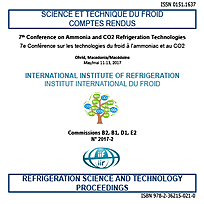
Document IIF
Consommation énergétique du processus d’abattage du saumon.
Energy consumption for salmon slaughtering processes.
Numéro : pap. n. 0014
Auteurs : ATES B., WIDELL K. N., NORDTVEDT T. S., et al.
Résumé
Today’s slaughtering and processing method for Atlantic salmon (Salmo salar) using large refrigerated seawater (RSW) and buffer tanks before and during a stepwise processing regime has now reached its limits. To overcome this problem, the salmon industry must, like the poultry industry, move towards automated online production, where the animal is quickly processed so all the energy (cooling and transport) can be focused on the meat only and not the surrounding water/ice and carcass. It is of importance to quantify the total energy consumption related to chilling and transport of Atlantic salmon. This enables to foresee and compare the energy requirements, costs and environmental impacts related to existing and new chilling technologies. A modern large slaughter facility in Norway that slaughter up to 125 000 tonnes of Atlantic salmon per year uses RSW tanks for fish cooling with a typical volume of 200-280 m3. This results in a significant amount of energy consumption for refrigeration. The objective of this paper was to describe the current situation at three different salmon slaughterhouses. The energy consumption were estimated and compared. In 2015, the specific energy consumption for these facilities were 105.7, 103.1 and 85.1 kWh/tonne, respectively. The refrigeration systems use ammonia as refrigerant, which is common in food processing industry in Norway.
Documents disponibles
Format PDF
Pages : 8
Disponible
Prix public
20 €
Prix membre*
Gratuit
* meilleur tarif applicable selon le type d'adhésion (voir le détail des avantages des adhésions individuelles et collectives)
Détails
- Titre original : Energy consumption for salmon slaughtering processes.
- Identifiant de la fiche : 30021789
- Langues : Anglais
- Source : 7th Conference on Ammonia and CO2 Refrigeration Technology. Proceedings: Ohrid, North Macedonia, May 11-13, 2017.
- Date d'édition : 11/05/2017
- DOI : http://dx.doi.org/10.18462/iir.nh3-co2.2017.0014
- Document disponible en consultation à la bibliothèque du siège de l'IIF uniquement.
Liens
Voir d'autres communications du même compte rendu (42)
Voir le compte rendu de la conférence
Indexation
-
Thèmes :
Ammoniac;
Poissons et produits de la mer - Mots-clés : Abattoir; Consommation d'énergie; Automatisation; Réfrigeration; R717; Saumon; Norvège; Étude de cas
-
Performance simulation of a refrigerated sea wa...
- Auteurs : TOLSTOREBROV I., EIKEVIK T. M., HAFNER A., et al.
- Date : 11/05/2017
- Langues : Anglais
- Source : 7th Conference on Ammonia and CO2 Refrigeration Technology. Proceedings: Ohrid, North Macedonia, May 11-13, 2017.
- Formats : PDF
Voir la fiche
-
Freezing of mackerel filets in a two-step freez...
- Auteurs : WIDELL K. N., NORDTVEDT T. S.
- Date : 11/04/2019
- Langues : Anglais
- Source : 8th Conference on Ammonia and CO2 Refrigeration Technology. Proceedings: Ohrid, North Macedonia, Avril 11-13, 2019.
- Formats : PDF
Voir la fiche
-
Improving energy efficiency in seafood freezing...
- Auteurs : SVENDSEN E. S., INDERGÅRD E., BENGSCH J., WIDELL K. N., KOSTER L., NORDTVEDT T. S.
- Date : 11/06/2024
- Langues : Anglais
- Source : 8th IIR International Conference on Sustainability and the Cold Chain. Proceedings: June 9-11 2024
- Formats : PDF
Voir la fiche
-
Design and simulations of refrigerated sea wate...
- Auteurs : BODYS J., SMOLKA J., BANASIAK K., et al.
- Date : 18/06/2018
- Langues : Anglais
- Source : 13th IIR Gustav Lorentzen Conference on Natural Refrigerants (GL2018). Proceedings. Valencia, Spain, June 18-20th 2018.
- Formats : PDF
Voir la fiche
-
Chilling of salmon in refrigerated sea water.
- Auteurs : BANTLE M., STAVSET O., NORDTVEDT T. S., et al.
- Date : 16/08/2015
- Langues : Anglais
- Source : Proceedings of the 24th IIR International Congress of Refrigeration: Yokohama, Japan, August 16-22, 2015.
- Formats : PDF
Voir la fiche
